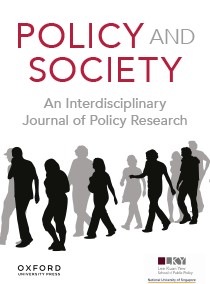Environmental impact assessments as a mechanism of regulatory intermediation: the case of Israeli wind energy
IF 6.1
1区 社会学
Q1 POLITICAL SCIENCE
引用次数: 0
Abstract
The environmental impacts of infrastructure projects are widely assessed through a procedure known as environmental impact assessments (EIAs). In many regulatory systems, EIAs are carried out by third-party intermediaries. However, their roles and effectiveness within public policy and regulatory governance remain understudied. This study addresses this gap by examining 24 wind energy projects deliberated in Israeli planning committees between 2003 and 2024. Specifically, we ask: (1) What intermediary roles do EIAs and those responsible for their implementation play? (2) What are the strengths and weaknesses of EIAs as an intermediation mechanism? (3) How do these strengths and weaknesses shape their effectiveness? Our analysis identifies five key intermediary roles: two formal roles, which are legally defined—providing advisory services and facilitating enforcement and compliance—and three informal roles, which extend beyond strict regulatory mandates—interpretation, dialogue facilitation, and advocacy. The formal roles ensure compliance with regulatory guidelines and advance environmental expertise, thereby meeting regulatory requirements and contributing to high procedural effectiveness. However, challenges persist, particularly regarding informal roles, which are often influenced by intermediaries’ alignment with developers’ interests. These challenges contribute to relatively low substantive effectiveness, as planning committees frequently find EIAs insufficient for informed decision-making, leading them to seek external consultants for validation. The gap between EIAs meeting regulatory requirements and planning committees’ inability to fully rely on them highlights weaknesses in EIA governance as a mechanism of regulatory intermediation. We argue that formalizing informal intermediary roles with clearer guidelines could improve EIA effectiveness, enhance objectivity, and strengthen decision-making in the EIA framework.环境影响评价作为管制中介机制:以色列风能案例
基础设施项目的环境影响是通过一种称为环境影响评估(eia)的程序进行广泛评估的。在许多监管制度中,环境影响评估是由第三方中介机构进行的。然而,它们在公共政策和监管治理中的作用和有效性仍未得到充分研究。本研究通过研究2003年至2024年间以色列规划委员会审议的24个风能项目来解决这一差距。具体来说,我们的问题是:(1)环评和负责实施环评的人扮演什么样的中介角色?(2)环评作为中介机制的优势和劣势是什么?(3)这些优势和劣势如何影响其有效性?我们的分析确定了五种关键的中介角色:两种正式角色,由法律定义,即提供咨询服务和促进执法和合规;三种非正式角色,超出严格的监管要求,即解释、促进对话和倡导。正式角色确保遵守监管指引和提高环境专业知识,从而满足监管要求,并有助于提高程序效率。然而,挑战仍然存在,特别是关于非正式的角色,这通常受到中介体与开发人员利益的一致性的影响。这些挑战导致实质性效力相对较低,因为规划委员会经常发现环境影响评估不足以作出知情的决策,导致它们寻求外部顾问进行验证。环评满足监管要求与规划委员会无法充分依赖环评之间的差距,凸显了环评治理作为监管中介机制的弱点。我们认为,将非正式中介角色正规化,并制定更明确的指导方针,可以提高环评的有效性,增强客观性,并加强环评框架中的决策。
本文章由计算机程序翻译,如有差异,请以英文原文为准。
求助全文
约1分钟内获得全文
求助全文
来源期刊

Policy and Society
Multiple-
CiteScore
18.00
自引率
6.50%
发文量
43
审稿时长
30 weeks
期刊介绍:
Policy and Society is a prominent international open-access journal publishing peer-reviewed research on critical issues in policy theory and practice across local, national, and international levels. The journal seeks to comprehend the origin, functioning, and implications of policies within broader political, social, and economic contexts. It publishes themed issues regularly and, starting in 2023, will also feature non-themed individual submissions.
 求助内容:
求助内容: 应助结果提醒方式:
应助结果提醒方式:


